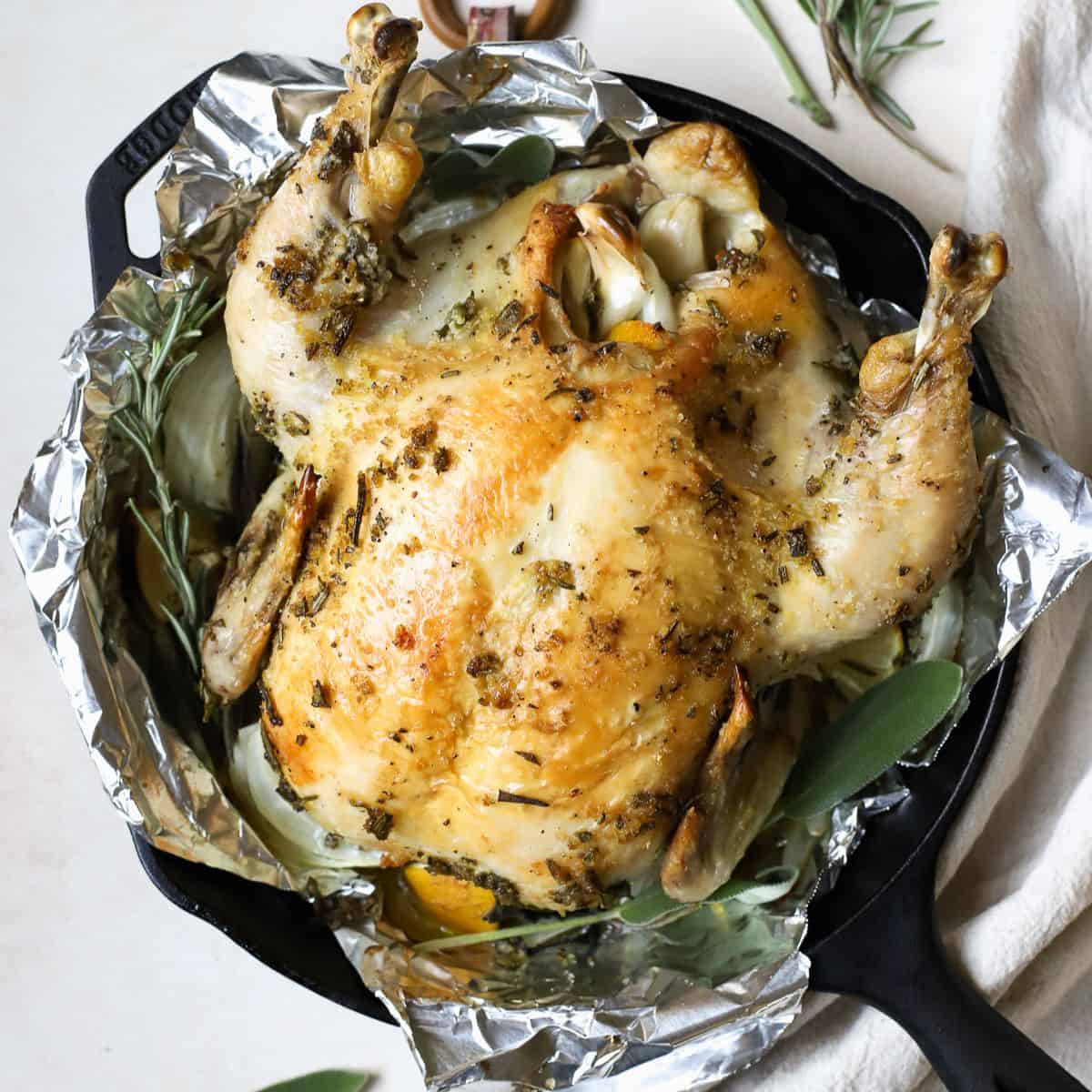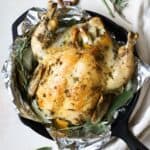If you want to learn how to roast an entire chicken at home with minimal ingredients and max flavor, then look no further! This simple whole roasted chicken with herbs is proof that you can roast a dang good whole chicken with little effort.
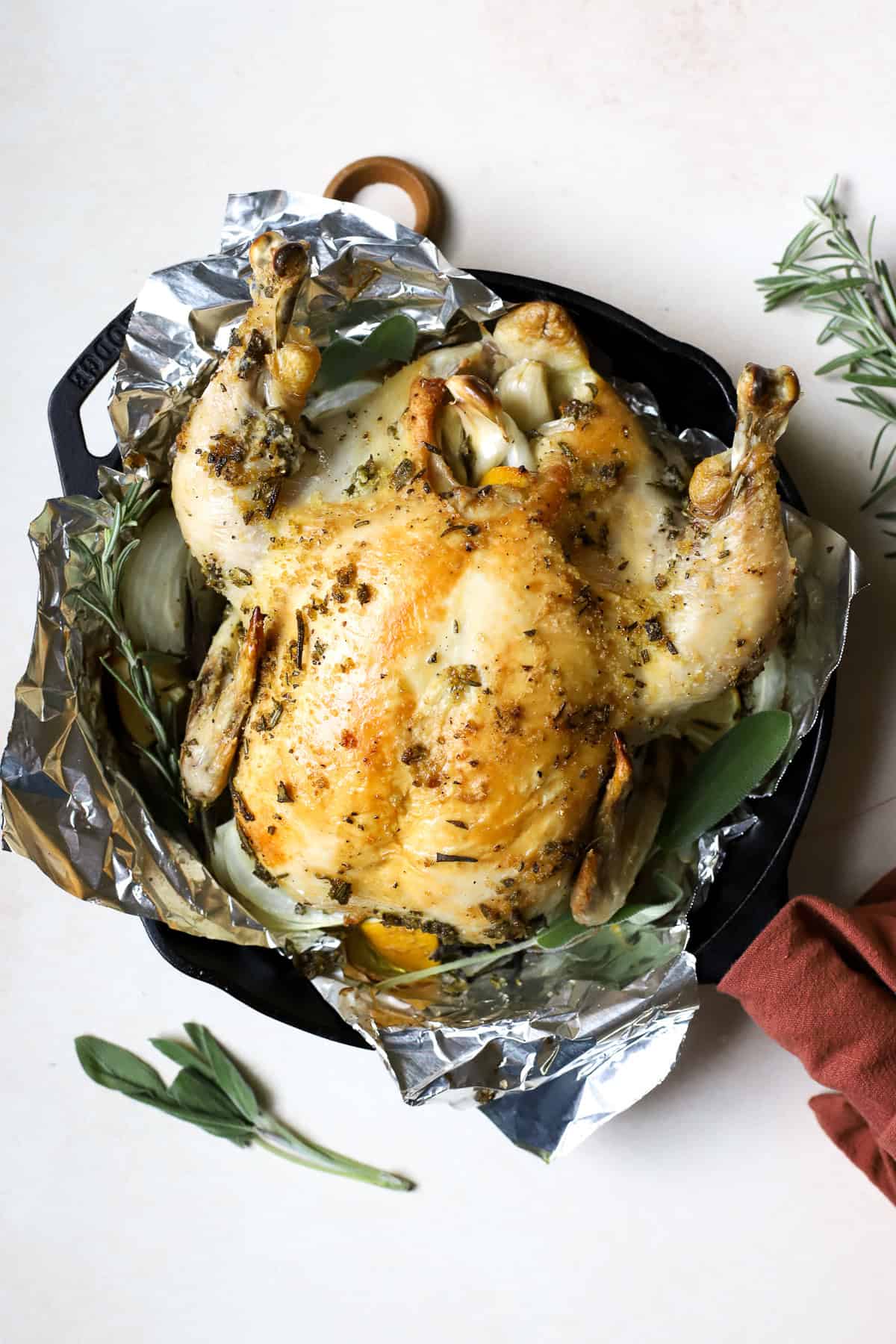
Sometimes in life, you just want to roast a whole chicken. You want the incredible house smells from fresh herbs, and you want the first bite of the fresh-from-the-oven, crispy skin as you pull the chicken apart. Not to mention the multiple meals you can make from the leftovers — white sauce chicken enchiladas, ginger lime chicken noodle soup, chicken salad with grapes and pecans, just to name a few. Whether it’s for a simple yet elegant dinner or just your casual weeknight meal where the leftovers end up saving your life that week, there’s something so satisfying about roasting a chicken yourself.
Over years of roasting chickens at home, I’ve been able to nail down a simple recipe that makes roasting a whole chicken feel like an easy meal that anyone can make with confidence. Let’s do it!
Jump to:
Ingredients
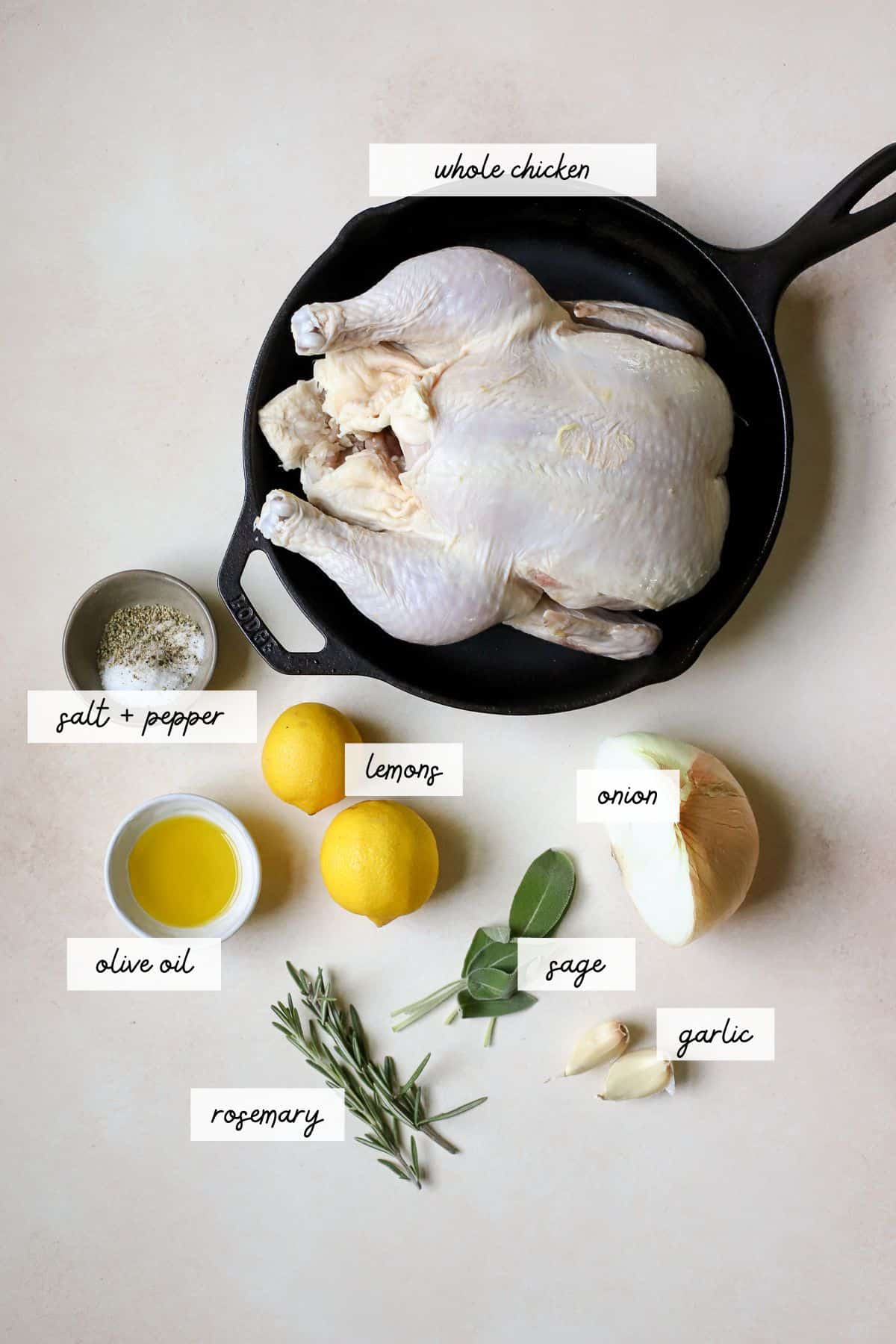
- Whole chicken – You can typically find whole chickens packaged near other cuts of chicken at most grocery stores.
- Onion, lemons, and garlic – These will be our basic aromatics for flavoring the chicken; some will be stuffed inside, while the rest will surround the chicken in the skillet.
- Extra virgin olive oil
- Sage and rosemary – Fresh herbs taste and smells amazing but you can also used dried. See substitutions section below for how to swap!
- Salt and pepper
Please see recipe card for quantities.
Substitutions & Variations
This roasted chicken recipe is very forgiving, so feel free to try the following swaps to make the recipe work for you!
- Dried herbs – I’ve made this recipe with both dried and fresh herbs, and have loved them equally. If you don’t have fresh herbs available or are trying to simplify the recipe as much as possible, swap in ½ tablespoon each of dried rosemary and sage. It sounds like a lot, but we do need to season a whole entire chicken!
- Butter – Use softened butter in place of the olive oil for a different delicious flavor. The butter will need to be at room temp so it’s spreadable, and you’ll simply mash it with the salt, pepper, and herbs to create a spreadable herbed butter. Spread it all over the chicken, including beneath the skin.
- Aromatics – I like to keep this recipe as basic as possible, so typically I keep to lemon, onion, and sometimes garlic. That said, if you have some carrots, celery, or other herbs that need to be used up, roughly chop them and add them in with onion and lemons.
How to Roast a Delicious Whole Chicken with Herbs
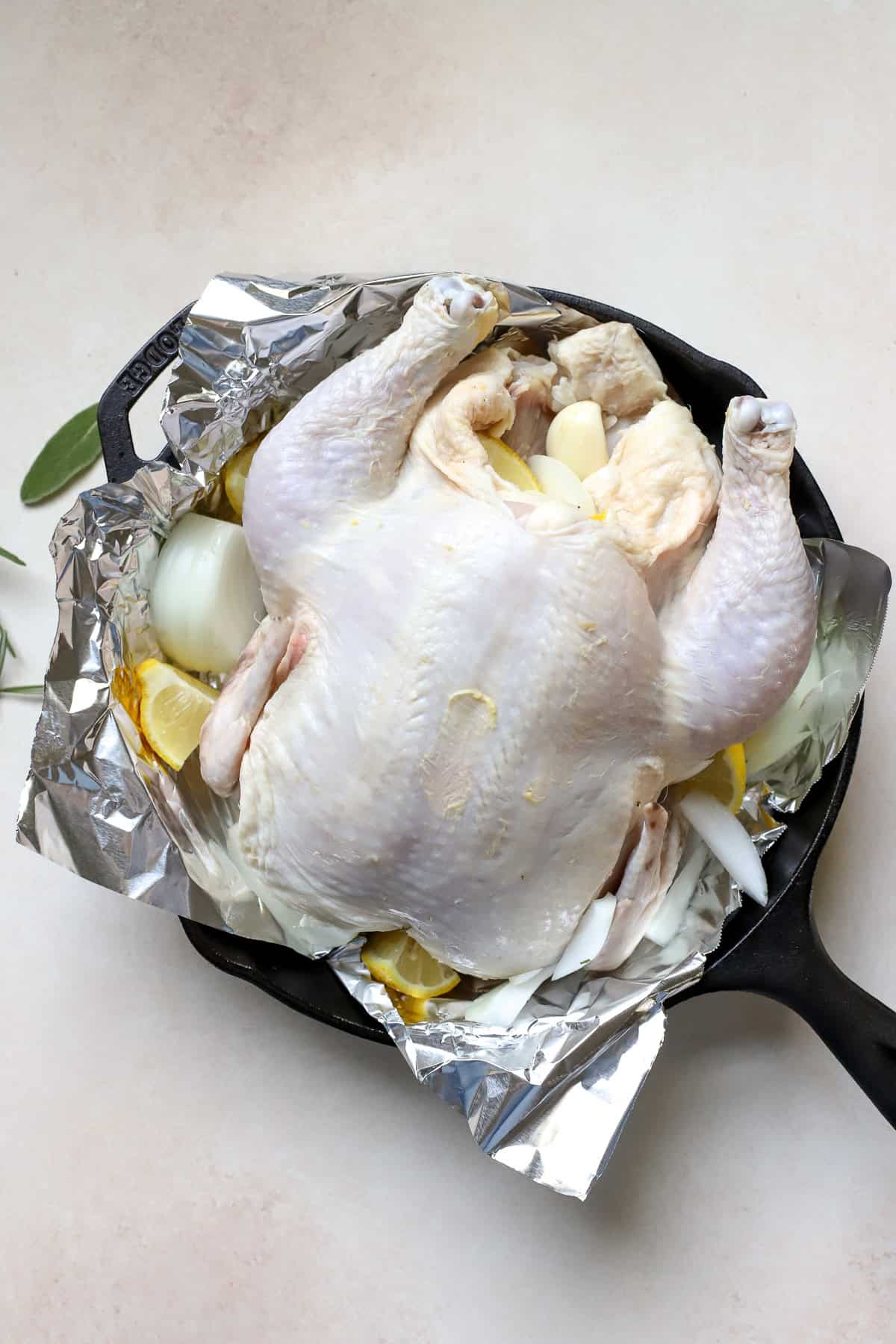
- Step 1: Preheat your oven to 425 degrees, and if desired, line a cast iron skillet (or oven-safe baking dish or skillet) with a square of aluminum foil. Remove the giblets from the chicken cavity and discard, then rinse the chicken and thoroughly pat dry with a paper towel. Place the chicken in the skillet, and set lemon wedges, onion, and garlic cloves around/under it, and stuff the chicken cavity with these ingredients as well.

- Step 2: Combine the olive oil, salt, pepper, rosemary, and sage in a small dish, and stir to form a seasoning paste.
- Step 3: Spread the olive oil and herb paste all over the chicken, making sure to get it in every nook and cranny. This means getting it underneath the chicken (opposite breast side), AND under the chicken skin itself. Simply loosen the skin (usually there’s an opening near the cavity), and get your hands right in there with the seasoning! Add a few more sprigs of rosemary and sage to the skillet around the chicken. You can also tie the legs together with kitchen twine, but I usually treat this step as optional.

- Step 4: Roast the chicken at 425 degrees, uncovered, for 50-60 minutes. All ovens are different, so I recommend using a meat thermometer to check the chicken temperature at 50 minutes to see if it’s done. Chicken should be cooked to 165 degrees, but note that the temperature will continue to increase for a couple minutes after you take it out of the oven. Keep the thermometer in the chicken for a couple minutes to observe. If it gets to 165, you can turn off your oven and let the chicken rest for 10 minutes. Then enjoy!
Pro tip! If you have time, salt your raw chicken hours before cooking it, and let it sit in your fridge until ready to cook. The salt will absorb into the meat, tenderizing and flavoring it from within.
Success Tips: Get Juicy Chicken and Crispy Skin
These are my top tips for avoiding dry chicken breast meat, and getting a juicy chicken with crispy, delicious skin.
- Use a meat thermometer to avoid overcooking. Chicken is considered safe to eat when cooked to 165 degrees Fahrenheit, but remember that the chicken will continue to cook once you take it out of the oven. To avoid drying out your chicken, ideally you’ll take it out of the oven before it reaches 165 degrees, then let it finish cooking with the heat that has built up inside of it. If it’s around 160, monitor the thermometer for a couple minutes to see if the temperature hits 165 on its own. Once it does, there is no need to continue cooking the chicken in the oven.
- Let the chicken rest. When you allow chicken to rest after cooking, the juices redistribute throughout the muscle fibers, creating super juicy and delicious results. Just that 10 extra minutes of resting will make a huge difference (though I know it’s tempting to dig right in…)!
- Prep your chicken properly for crispy skin. To get super crispy skin, rinse and thoroughly dry your chicken with a paper towel before you roast it. This helps reduce any moisture that would create steam in the oven, which does not crisp up food – we need a dry heat. As a second step, fully coating the chicken in the olive oil mixture helps with crisping as well. When I’m very prepared (definitely not always), I salt the chicken all over and store it in the fridge until I’m ready to cook. If you’ve read Salt Fat Acid Heat, you know that this tenderizes and flavors the meat from the inside out.
Some people also cook the chicken at a high temperature (such as 450) for 15-20 minutes, then reduce it to 350 or 375 to finish it out. I haven’t personally tested this way yet, but please let me know how it goes if you do!
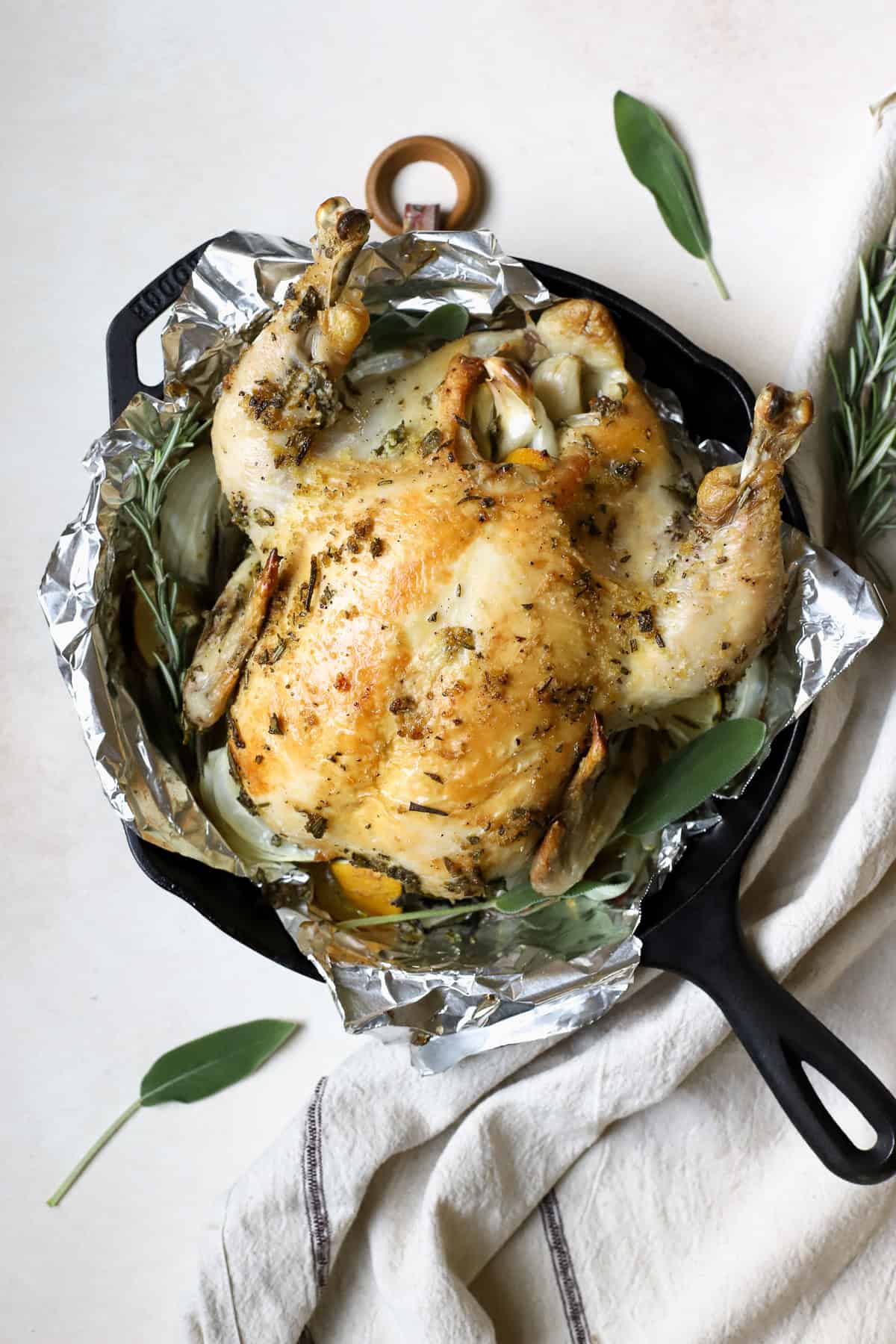
Roasted Chicken FAQs
If you’re not planning to use them, you can discard them after all of the chicken has been removed. Lately I’ve been simmering them with aromatics and water to make homemade chicken bone broth. If you’re not able to make this right away, simply freeze the bones in an airtight container for a time when you can.
Any leftover chicken can be stored in an airtight container in the fridge for up to a week. Chicken can also be frozen, so just pop that same airtight container in the freezer for up to three months, and thaw in the fridge overnight before use.
Pairing
These are some of our favorite side dishes to go with a whole roasted chicken! Feel free to peruse all of our healthy side dishes as well.
Did you try this simple roasted chicken recipe? Don’t forget to leave a star rating 🌟 and comment below, and tag me on Instagram and Pinterest so I can see what you made!
📖 Recipe
Crispy and Simple Roasted Chicken with Herbs
This simple whole roasted chicken recipe is made with fresh herbs and comes together in about an hour for the perfect elegant, nourishing dinner and most amazing house smells (and leftovers!).
- Prep Time: 10 minutes
- Cook Time: 60 minutes
- Total Time: 1 hour 10 minutes
- Yield: ~6 servings
- Category: Dinner
- Method: Oven roast
- Cuisine: American
Ingredients
Units
Scale
- 1 4-5 pound whole chicken
- 1 sweet or yellow onion, peeled and roughly chopped
- 2–3 lemons, cut into quarters
- ¼ cup extra virgin olive oil
- 3–4 sprigs of fresh rosemary
- 5–7 fresh sage leaves
- Heaping ½ tablespoon salt
- 1 teaspoon pepper
Instructions
- Preheat and prepare chicken. Preheat your oven to 425 degrees. Rinse the chicken in the sink and thoroughly dry with paper towel. The drier the skin, the crispier it’ll get! If desired, line your baking dish or cast iron skillet with aluminum foil. It’s not necessary, but can help reduce clean-up after. Set the chicken in the skillet while you make the seasoning paste.
- Make herb seasoning paste. Combine finely chopped rosemary and sage leaves with salt, pepper, and olive oil. Stir to combine and form a paste.
- Season chicken. Stuff the chicken with onion and lemon wedges, plus a rosemary twig and a couple sage leaves. Place the remaining onion, lemon wedges, garlic cloves, and a couple rosemary and sage twigs around the chicken in the skillet. Rub the seasoning all over the chicken, both thigh-side (usually facedown when cooking) and breast-side, even getting it underneath the chicken skin.
- Roast chicken. Roast the chicken, uncovered, at 425 degrees for 50-60 minutes. At minute 50, take the chicken out and check the internal temperature with a meat thermometer. If it’s close to 165 degrees, keep the thermometer in the chicken and monitor as the chicken continues to cook outside of the oven. If it doesn’t reach 165, give it a couple more minutes in the oven. If it does, turn off the oven and let the chicken rest for 10 minutes before cutting and serving.
Notes
- Chicken size. This recipe is written for a 4-5 pound chicken, and has been tested most with that size. Note that a smaller chicken will cook faster, so you’ll likely need to check the temperature earlier (around 45 minutes).
- Storage & freezing. To store leftover chicken, cut it off of the bone and place in an airtight container for up to a week. You can also freeze it for up to three months.Leftovers are great in soup! Also, instead of discarding bones, you can freeze them or use right away to make chicken stock or bone broth.
- Kitchen twine. Some people prefer to tie the chicken legs together with kitchen twine to bring them closer to the body for a more even cooking experience. I have found success either way, so I usually treat this as optional. Feel free to do so, if you’d like!
Nutrition
- Serving Size: About a cupful
- Calories: 322
- Sugar: 3.3 g
- Sodium: 754.6 mg
- Fat: 11.2 g
- Saturated Fat: 2.3 g
- Carbohydrates: 8.5 g
- Fiber: 1.1 g
- Protein: 46.7 g
- Cholesterol: 147.3 mg
